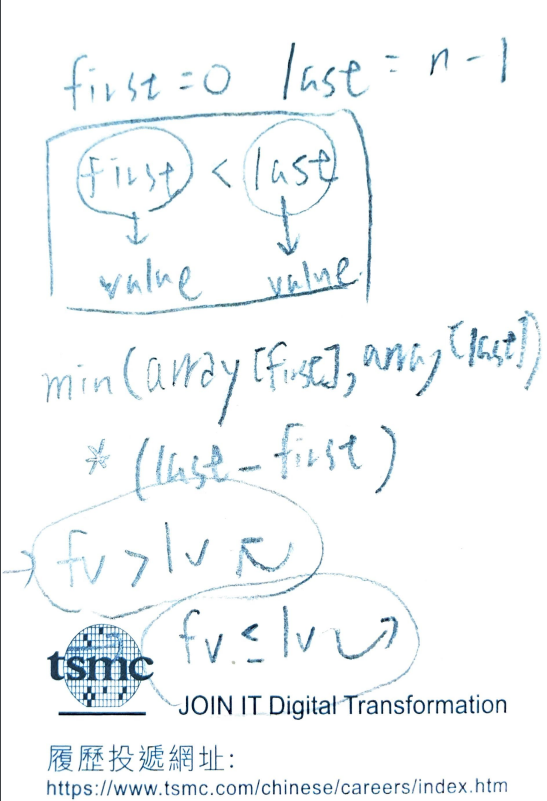描述:
Given n non-negative integers a1, a2, ..., an , where each represents a point at coordinate (i, ai). n vertical lines are drawn such that the two endpoints of line i is at (i, ai) and (i, 0). Find two lines, which together with x-axis forms a container, such that the container contains the most water.
Note: You may not slant the container and n is at least 2.
相當有趣的一題
題意: 好幾根柱子 高高低低,選兩柱 中間裝水,問最大水量。
思路: 任選兩柱 以較矮柱為高,因此得
min(height[left],height[right])
那寬度呢?
不要忘記 我們要求的是 最大面積,所以越寬越好(也就是說兩柱離越遠越好),
但是呢 面積為 長x寬 而 長以矮的為主,所以阿 感覺是每一種組合都得試試~~
起初 是以 double for 來組,再取最大 ... 但是會超時 QQ
所以看了 GeeksforGeeks - Container with Most Water 的 Algorithm
遵循 Wait a day : 談談 寫程式技巧 寫了個 草稿大致怎麽做
再想了一下,覺得那個 左右 移動很有道理 > 就是要找 較高的柱
左柱(左指針) 初始為 最左邊的那根
右柱(右指針) 初始為 最右邊的那根
如果 左柱 低於 右柱
左指針右移 找較高的柱
如果 右柱 低於 左柱
右指針左移 找較高的柱
過程中 紀錄目前面積最大的(在考慮兩柱取矮柱的條件下)
如果大於目前最大則更新,最後(左指針<右指針都跑完的情況)面積為所求。
正解
class Solution:
def maxArea(self, height: List[int]) -> int:
'''
ans = 0
left = 0
right = (len(height)-1)
for i in range(len(height)):
for j in range(i+1,len(height)):
#print(j)
v = min(height[i],height[j])
area = v*(j-i)
if area > ans:
ans = area
v1 = i
v2 = j
#print(ans)
#print("v1"+str(v1))
#print("v2"+str(v2))
return ans
'''
last = len(height)-1
first = 0
ans = 0
while first < last:
cur = min(height[first],height[last])*(last-first)
print("cur:"+str(cur))
if cur > ans:
ans = cur
if height[first] > height[last]:
last -=1
else:
first += 1
print(ans)
return ans
PS: 註解為 TTL 時的 Code
Note: print 盡量拿掉 因為太多print 可能造成 Runtime Error
Result
